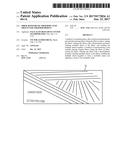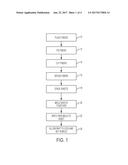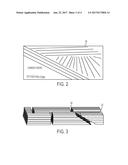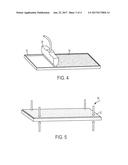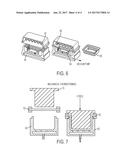Patent application title: FIBER REINFORCED THERMOPLASTIC SHEETS FOR THERMOFORMING
Inventors:
Victor Alfred Beck (Menlo Park, CA, US)
IPC8 Class: AB29C4302FI
USPC Class:
1 1
Class name:
Publication date: 2017-06-22
Patent application number: 20170173826
Abstract:
A method of manufacturing a fiber reinforced thermoplastic part includes
placing fibers, fixing the fibers in place, cutting the fibers, infusing
the fibers with a thermoplastic polymer, stacking multiple sheets of the
fibers, and molding the multiple sheets together. A method of
manufacturing a part includes placing original fibers, fixing the fibers
in place, cutting the fibers, infusing the fibers with a thermoplastic
polymer, stacking multiple sheets of the fibers, molding the multiple
sheets together to form a moldable sheet, and applying a mold to the
moldable sheet.Claims:
1. A method of manufacturing a fiber reinforced thermoplastic part,
comprising: placing fibers; fixing the fibers in place; cutting the
fibers; infusing the fibers with a thermoplastic polymer; stacking
multiple sheets of the thermoplastic infused fibers; and molding the
multiple sheets together.
2. The method of manufacturing of claim 1, wherein fixing the original fibers comprises spraying the original fibers with a binder.
3. The method of manufacturing of claim 1, wherein cutting the fixed fibers into multiple small fibers comprises using at least one laser to cut the fixed fibers.
4. The method of manufacturing of claim 1, wherein infusing the multiple smaller fibers comprises one of slot coating or infusion molding.
5. The method of manufacturing of claim 1, wherein stacking the multiple sheets comprises stacking the sheets according to a predetermined arrangement of the cuts.
6. The method of manufacturing of claim 1, wherein the fibers are cut prior to infusing the fibers with a thermoplastic polymer.
7. The method of manufacturing of claim 1, wherein the fibers are infused prior to being cut.
8. The method of manufacturing of claim 1, wherein the fibers are fixed prior to being cut.
9. The method of manufacturing of claim 1, wherein the fibers are temporarily held in place and cut prior to being fixed.
10. The method of manufacturing of claim 1, further comprising: determining a pre-deformed two-dimensional pattern; and using an automated fiber placement machine to place the fibers.
11. A method of manufacturing a part, comprising: placing original fibers; fixing the fibers in place; cutting the fibers; infusing the fibers with a thermoplastic polymer; stacking multiple sheets of the thermoplastic infused fibers; molding the multiple sheets together to form a moldable sheet; and applying a mold to the moldable sheet.
12. The method of manufacturing of claim 11, wherein fixing the original fibers comprises spraying the original fibers with a binder.
13. The method of manufacturing of claim 11, wherein cutting the fixed fibers into multiple small fibers comprises using at least one laser to cut the fixed fibers.
14. The method of manufacturing of claim 11, wherein infusing the multiple smaller fibers comprises one of slot coating or infusion molding.
15. The method of manufacturing of claim 11, wherein stacking the multiple sheets comprises stacking the sheets according to a predetermined arrangement of the cuts.
16. The method of manufacturing of claim 11, wherein the fibers are held in place and cut prior to infusing the fibers with a thermoplastic polymer.
17. The method of manufacturing of claim 11, wherein the fibers are infused prior to being cut.
18. The method of manufacturing of claim 11, wherein the fibers are fixed prior to being cut.
19. The method of manufacturing of claim 11, wherein the fibers are cut prior to being fixed.
Description:
FIELD OF THE INVENTION
[0001] This disclosure relates to thermoforming, more particularly to thermoforming with reinforced thermoplastic sheets.
BACKGROUND
[0002] Thermoforming provides a rapid, efficient, and inexpensive method to make complicated parts from thermoplastics. However, the mechanical properties of thermoplastic polymers makes them unsuitable for more demanding applications, such as in the automotive and aerospace industries. These industries use heavier and more expensive materials like steel and aluminum for their stamping and forming processes. Thermoplastics are lighter and more efficient and would be good replacements for these materials, if not for their poor mechanical performance.
[0003] Adding reinforcement would improve the mechanical performance of thermoplastics. Currently, no acceptable method exists to introduce reinforcement in a manner that controls the orientation and alignment into a thermoplastic sheet that can then undergo thermoforming. In addition to the mechanical performance requirements, thermoforming of the thermoplastics needs to fit into the existing manufacturing processes to ensure that speed and efficiencies are maintained. Any materials introduced into those processes must have comparable flexibility, machinability and manufacturability, and good joining characteristics with other materials and thermoformed parts.
SUMMARY
[0004] One embodiment is a method of manufacturing a fiber reinforced thermoplastic part includes placing fibers, fixing the fibers in place, cutting the fibers, infusing the fibers with a thermoplastic polymer, stacking multiple sheets of the fibers, and molding the multiple sheets together.
[0005] One embodiment is a method of manufacturing a part which includes placing original fibers, fixing the fibers in place, cutting the fibers, infusing the fibers with a thermoplastic polymer, stacking multiple sheets of the fibers, molding the multiple sheets together to form a moldable sheet, and applying a mold to the moldable sheet.
BRIEF DESCRIPTION OF THE DRAWINGS
[0006] FIG. 1 shows a flowchart of one embodiment of a method to manufacture a fiber reinforced thermoplastic sheet.
[0007] FIG. 2 shows an embodiment of a two-dimensional preform having long fixed fibers.
[0008] FIG. 3 shows an embodiment of cut bundles of fibers.
[0009] FIG. 4 shows an embodiment of forming a moldable sheet.
[0010] FIG. 5 shows an embodiment of infusing the sheet with a polymer.
[0011] FIG. 6 shows an embodiment of molding a thermoplastic sheet.
[0012] FIG. 7 shows an embodiment of molding a part from a thermoplastic sheet.
DETAILED DESCRIPTION OF THE EMBODIMENTS
[0013] FIG. 1 shows a flow chart of a method of manufacturing a fiber reinforced thermoplastic sheet. One should note that the method shown here provides one order of the processes involved in manufacturing a fiber reinforced thermoplastic. As will be discussed in more detail further, the order of some of the processes may vary. Initially, the process places long fibers at 12, typically using an automated fiber placement machine but can be placed in any manner. The placement of the fibers may occur in accordance with a pre-determined two-dimensional pattern, where the two-dimensional pattern is determined from a final three-dimensional desired shape. FIG. 2 shows an example of such a pattern 30.
[0014] In the embodiment of FIG. 1, the placed fibers are then fixed into place at 12, such as with a spray on binder or other means to set the fibers in place. The long fibers, after being fixed into place, typically run in one direction and cannot bend significantly in the other directions, especially when surrounded by a high density of the fibers. They have the advantage of being very strong, but with their inherent inflexibility may not work for many applications. Specifically, it would be impossible to mold the fibers into a three dimensional shape without breaking the fibers or causing them to be catastrophically pulled from their specified location. In order to overcome this, the process nicks the long fibers at 14 to form short fibers. In one embodiment, the laser ablation forms the nicks to cut the long fibers. The nicks are positioned to ensure necessary compliance before molding into the desired shape. FIG. 3 shows an example of nicked fibers 32, having strategically placed cuts 34.
[0015] As mentioned above, the order of many of these steps may change depending upon the application. In one embodiment, the fibers could be cut, then fixed or bound. In another, the fibers could be fixed and then cut. In the embodiment of FIG. 1, the fibers are infused with a polymer at 16 after being cut. FIG. 4 shows an example of a sheet such as 32 being infused with a polymer through a deposition or infusion head 36. Again, this order is dependent upon the application. The process could also have the cut fibers pressed together and then infused, if the fibers are temporarily held in place prior to cutting. The fibers must be fixed or temporarily held in place before infusion with polymer. The temporary holding in place can be accomplished by applying pressure using two flat plates as done during a typical infusion as shown in FIG. 5.
[0016] After infusion, in this embodiment, the infused sheets are stacked together at 18 in FIG. 1 and then fused together. FIG. 5 shows an example of the sheets undergoing pressing to mold them together at 20 in FIG. 1 to form a new moldable sheet. This sheet now consists of a fiber reinforced thermoplastic sheet that has flexibility in multiple directions, and sufficient strength to allow it to replace metal parts. The stacking of the sheets may occur with a particular order to arrange the fibers and cuts according to a desired shape. The molding may occur under pressure. FIG. 5 shows an example of a fixture 36 in which the nicked fibers 32 that can press the fibers together.
[0017] At this point, the fiber-reinforced polymer sheets are now suitable for many different applications, including forming of parts that would otherwise be formed from stamping of metals. In FIG. 1, heat is applied to the thermoplastic sheet to cause the polymers to flow, then the part mold is applied to the moldable sheet at 22 and the sheet allowed to cool to form the part 24. FIGS. 6 and 7 show this in more detail.
[0018] In FIG. 6, the mold 60 is applied to the sheet 62. Heaters 66 cause the sheet to drop in viscosity and flow into the mold which forms it into the desired shape of the part 64. A vacuum pump may pull out any fluids released by the heating process and removes any air that may be trapped in the sheet as it is heated and set. It also creates a vacuum which pulls the molten polymer down into the mold. The resulting part 64 consists of a fiber-reinforced, thermoplastic polymer having the fibers oriented according to a particular pattern determined by the shape of the desired parts. This creates a part with high fiber alignment and density wherein the fibers are preferentially oriented to optimally accommodate the stresses in the part.
[0019] It will be appreciated that variants of the above-disclosed and other features and functions, or alternatives thereof, may be combined into many other different systems or applications. Various presently unforeseen or unanticipated alternatives, modifications, variations, or improvements therein may be subsequently made by those skilled in the art which are also intended to be encompassed by the following claims.
User Contributions:
Comment about this patent or add new information about this topic:

